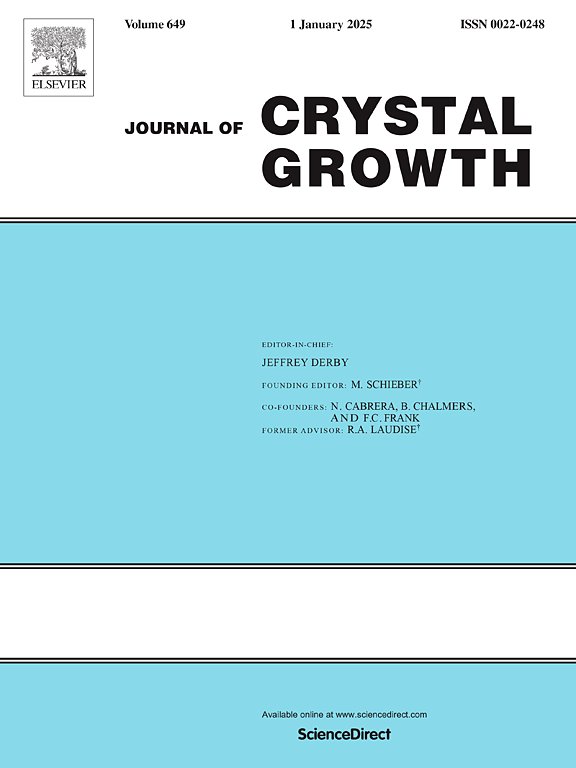Optimizing cooling strategies in the Czochralski process for large-diameter silicon ingots
IF 2
4区 材料科学
Q3 CRYSTALLOGRAPHY
引用次数: 0
Abstract
As the semiconductor industry shifts towards larger wafer sizes, such as 300 mm and 450 mm, controlling defects is crucial to ensure device performance and yield. Conversely, a high cooling rate is essential for achieving higher production rates. Therefore, finding the optimal cooling strategy is critical to maintaining high production rates while ensuring high-quality wafer production. This paper employs a simulation model to investigate the impact of various cooling strategies on point defect formation during the CZ process for 450 mm diameter silicon ingots. Using the 3D energy equation coupled with the Navier-Stokes equation and moving mesh theory, the transient CZ process is simulated, incorporating defect evaluation equations. Beside original CZ puller configuration, two cooling strategies are examined: one with a small gap and long cooling jacket (Case II) and another with a large gap and short cooling jacket (Case III), compared against a baseline setup (Case I). The simulations reveal that Case II, while enhancing the crystallization rate, increases non-uniformity. Conversely, Case III produces a flatter solid-liquid interface and lower defect concentrations, achieving a maximum Cv-Ci of 0.4 × 1014 cm−3, compared to 1.1 × 1014 cm−3 and -2.5 × 1014 cm−3 in Case I and II. These findings suggest that adjusting cooling strategies can significantly impact the quality and uniformity of large- diameter silicon ingots.
优化大直径硅铸锭的 Czochralski 工艺冷却策略
随着半导体行业向 300 毫米和 450 毫米等更大晶圆尺寸转变,控制缺陷对于确保设备性能和产量至关重要。相反,高冷却率对于实现更高的生产率至关重要。因此,找到最佳冷却策略对于保持高生产率同时确保高质量晶圆生产至关重要。本文采用仿真模型来研究 450 毫米直径硅锭 CZ 工艺过程中各种冷却策略对点缺陷形成的影响。利用三维能量方程、纳维-斯托克斯方程和移动网格理论,模拟了瞬态 CZ 过程,并纳入了缺陷评估方程。除了原始的 CZ 拉拔器配置外,还研究了两种冷却策略:一种是小间隙和长冷却套(情况 II),另一种是大间隙和短冷却套(情况 III),并与基准设置(情况 I)进行了比较。模拟结果表明,情况 II 在提高结晶速率的同时,也增加了不均匀性。相反,情况 III 产生了更平坦的固液界面和更低的缺陷浓度,最大 Cv-Ci 为 0.4 × 1014 cm-3,而情况 I 和情况 II 分别为 1.1 × 1014 cm-3 和 -2.5 × 1014 cm-3。这些研究结果表明,调整冷却策略可显著影响大直径硅锭的质量和均匀性。
本文章由计算机程序翻译,如有差异,请以英文原文为准。
求助全文
约1分钟内获得全文
求助全文
来源期刊

Journal of Crystal Growth
化学-晶体学
CiteScore
3.60
自引率
11.10%
发文量
373
审稿时长
65 days
期刊介绍:
The journal offers a common reference and publication source for workers engaged in research on the experimental and theoretical aspects of crystal growth and its applications, e.g. in devices. Experimental and theoretical contributions are published in the following fields: theory of nucleation and growth, molecular kinetics and transport phenomena, crystallization in viscous media such as polymers and glasses; crystal growth of metals, minerals, semiconductors, superconductors, magnetics, inorganic, organic and biological substances in bulk or as thin films; molecular beam epitaxy, chemical vapor deposition, growth of III-V and II-VI and other semiconductors; characterization of single crystals by physical and chemical methods; apparatus, instrumentation and techniques for crystal growth, and purification methods; multilayer heterostructures and their characterisation with an emphasis on crystal growth and epitaxial aspects of electronic materials. A special feature of the journal is the periodic inclusion of proceedings of symposia and conferences on relevant aspects of crystal growth.
 求助内容:
求助内容: 应助结果提醒方式:
应助结果提醒方式:


